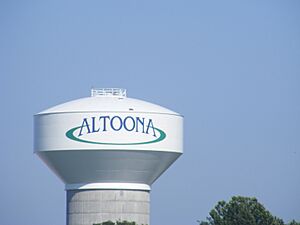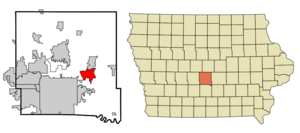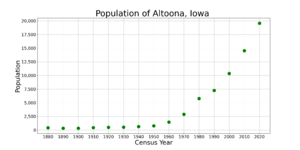Altoona, Iowa facts for kids
Quick facts for kids
Altoona, Iowa
|
|
|---|---|

Altoona water tower
|
|

Location within Polk County and Iowa
|
|
| Country | United States |
| State | Iowa |
| County | Polk |
| Area | |
| • Total | 11.69 sq mi (30.28 km2) |
| • Land | 11.68 sq mi (30.25 km2) |
| • Water | 0.01 sq mi (0.03 km2) |
| Elevation | 958 ft (292 m) |
| Population
(2020)
|
|
| • Total | 19,565 |
| • Rank | 26th in Iowa |
| • Density | 1,675.09/sq mi (646.76/km2) |
| Time zone | UTC-6 (Central (CST)) |
| • Summer (DST) | UTC-5 (CDT) |
| ZIP code |
50009
|
| Area code(s) | 515 |
| FIPS code | 19-01630 |
| GNIS feature ID | 2393939 |
Altoona is a city in Polk County, Iowa, United States. It is part of the Des Moines metropolitan area. In 2020, about 19,565 people lived there. Altoona is famous for its Adventureland amusement park and the Prairie Meadows horse racing track and casino.
Contents
Discovering Altoona: A City's Journey
Altoona is a lively city with a rich past and exciting present. It offers fun attractions and a growing community. Let's explore how this city came to be and what makes it special today.
Altoona's Beginnings: How It Started
The area where Altoona now stands was first settled in 1854 by Anthony Yant and Gilbert T. Taylor. The land was surveyed in 1847 and sold by the U.S. government in 1848. After several land sales, the Davis family owned the land by 1868.
The Davises hired Julian B. Bausman to plan the city. He named it Altoona, from the Latin word altus, meaning "high." This was because Altoona was the highest point on the Des Moines Valley Railroad between Des Moines and Keokuk.
The city's plan was officially recorded on July 30, 1868. The Post Office opened the very next day. When the Rock Island Railroad arrived in September 1868, they called the area "Yant," its original name. Altoona officially became a city on March 11, 1876.
Leaders Who Shaped Altoona
Altoona has had many important leaders.
- Francis English was the city's first mayor and also a doctor. He helped people after a big train crash in 1877.
- Thomas Haines was the second mayor. He owned a tile and brick company. Haines gave land to the city for a park, which is now called Haines Park.
- Sam Wise was another important mayor. He made sure Altoona's streets were paved and built a modern sewer system. The city's sports complex is named the "Sam Wise Youth Complex" because of his dedication to parks.
From Coal to Computers: Altoona's Growth
Around 1900, Altoona was a busy coal mining town. Many people worked in the mines. The United Mine Workers of America Local 407 was formed in Altoona in 1897.
In 2003, the Altoona City Council recognized the Altoona Area Historical Society. This group collects and saves important items and records about the city's history. In 2011, they opened a museum in Altoona's oldest building.
In recent years, Altoona has seen new developments. In 2013, Facebook started building a large data center here. They even worked with a local company to build a wind farm. This wind farm creates more energy than the data center uses! In 2016, a new Cinemark movie theater opened in Altoona.
Where is Altoona? Geography
Altoona covers about 9.35 square miles (24.22 square kilometers) of land.
Altoona's People: Demographics
| Historical population | |||
|---|---|---|---|
| Census | Pop. | %± | |
| 1880 | 400 | — | |
| 1890 | 326 | −18.5% | |
| 1900 | 328 | 0.6% | |
| 1910 | 438 | 33.5% | |
| 1920 | 502 | 14.6% | |
| 1930 | 514 | 2.4% | |
| 1940 | 640 | 24.5% | |
| 1950 | 763 | 19.2% | |
| 1960 | 1,458 | 91.1% | |
| 1970 | 2,883 | 97.7% | |
| 1980 | 5,764 | 99.9% | |
| 1990 | 7,242 | 25.6% | |
| 2000 | 10,345 | 42.8% | |
| 2010 | 14,541 | 40.6% | |
| 2020 | 19,565 | 34.6% | |
| Iowa Data Center | |||
Population Changes Over Time
The population of Altoona has grown a lot over the years. In 1880, there were about 400 people. By 2020, the population had grown to 19,565 people. This shows how much the city has expanded!
Who Lives in Altoona?
In 2020, there were 19,565 people living in Altoona. There were 7,575 households. About 34.2% of these households had children under 18 living with them. The average age of people in Altoona was 36.7 years. About 28.2% of residents were under 20 years old.
Learning in Altoona: Education
Altoona is part of the Southeast Polk Community School District. Students from Altoona attend Southeast Polk High School. The city has four elementary schools: Altoona, Centennial, Clay, and Willowbrook. The Altoona Elementary building used to be the town's high school until 1962.
Getting Around: Transportation
Bus service in Altoona is provided by Des Moines Area Regional Transit. Routes 17 and 99 connect the city to other areas.
Famous Faces: Notable People
Many interesting people have connections to Altoona:
- John Falsey (1951–2019), a writer, director, and producer of TV shows.
- John Houbolt (1919–2014), an aerospace engineer who helped plan how to go to the Moon.
- Geri Huser (born 1963), a Democratic representative in the Iowa House.
- Kyle Orton (born 1982), a former NFL quarterback.
- Ed Skinner (1936–2015), an Iowa lawyer and lawmaker.
- Neal Edward Smith (1920–2021), a former U.S. Representative from Iowa.
- Jamie Solinger, who was Miss Iowa Teen USA in 1992 and Miss Teen USA 1992, and Miss Iowa USA in 1998.
See also
 In Spanish: Altoona (Iowa) para niños
In Spanish: Altoona (Iowa) para niños


